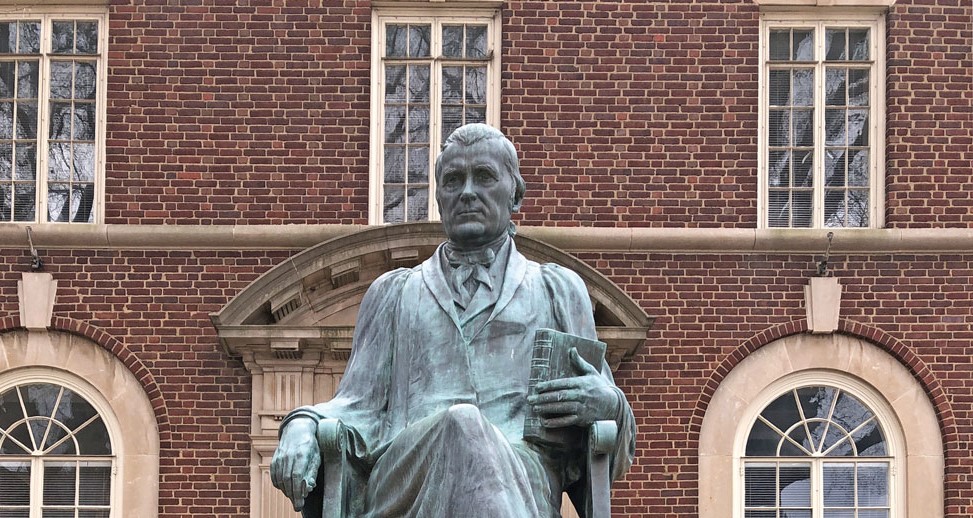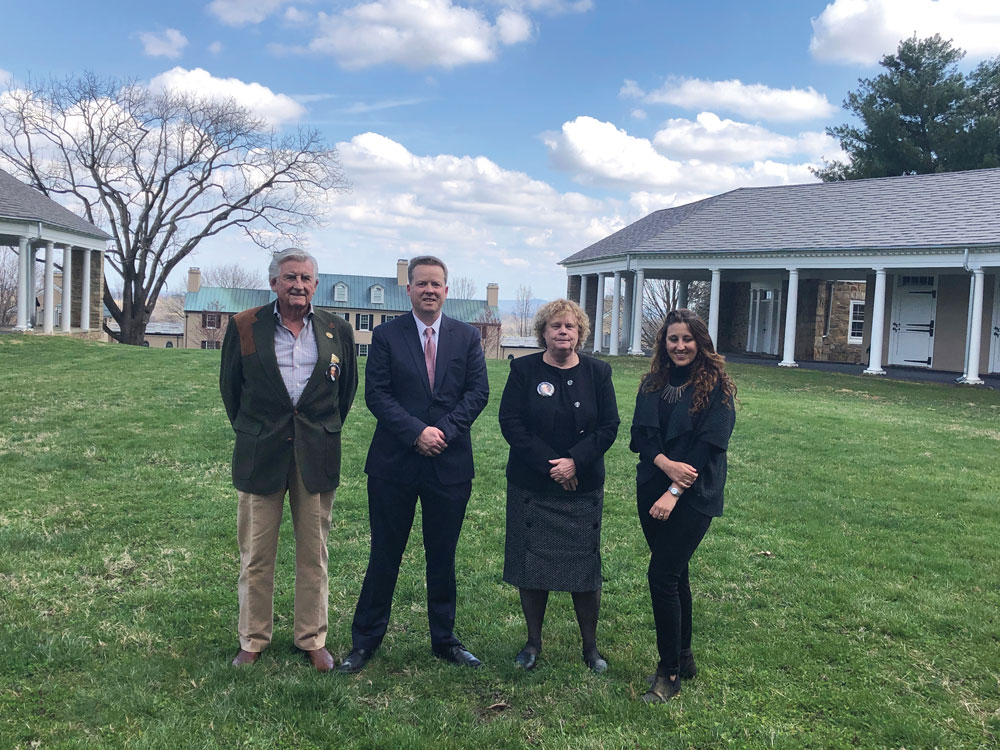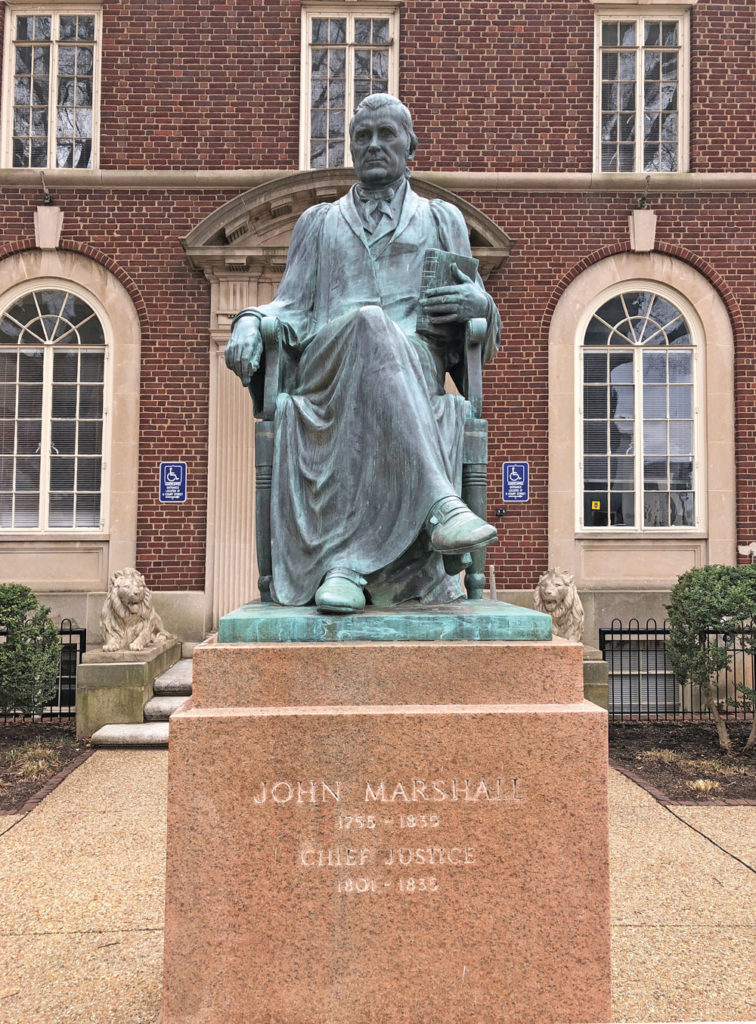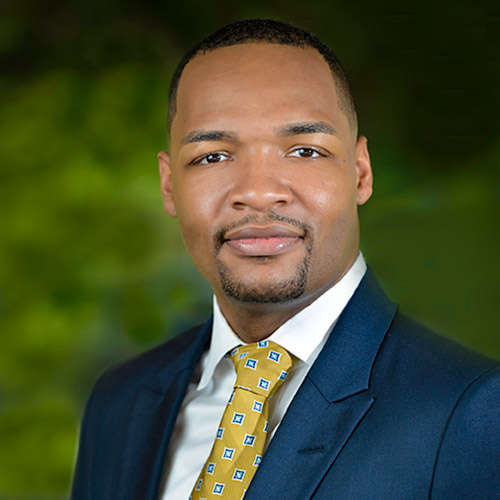John Marshall, native Fauquier Son Turned National Icon

By Heidi Baumstark
“We the People …” Those three words opening the U.S. Constitution speak of the power of the people who grant the government its powers. And Fauquier native, John Marshall, worked to help ratify the Constitution in 1789, which became the guideline for the type of government we have today.
On April 6, Mosby Heritage Area Association (MHAA) sponsored a symposium titled “The Life and Legacy of John Marshall: The Great Chief Justice.” It was held at Llangollen in Upperville, an 18th estate in Loudoun County at the foot of the Blue Ridge Mountains on land that was once owned by the Marshall family. The Brennan family is the current steward of Llangollen and Donald Brennan is a board member of MHAA. This is one of several programs MHAA is hosting to commemorate the bicentennial of the landmark case McCulloch v. Maryland (1819), which is one of the first and most important Supreme Court cases on federal power.

Throughout the day, four speakers unfolded the life of Marshall in Llangollen’s spacious Horseshoe Barn. Scholars, attorneys and history enthusiasts packed the barn mingling with others interested in learning more about Marshall’s legacy, which includes serving in the Revolutionary War with George Washington, representing Fauquier County in the Virginia General Assembly, serving in the U.S. House of Representatives and as Secretary of State. However, his most important legacy was in his role as the fourth Chief Justice of the Supreme Court appointed in the final days of John Adams’ presidency in 1801. He spent over three decades in the court shaping the power of the judiciary branch of government.
Speakers included Jennifer Hurst-Wender, Director of Museum Operations and Education for Preservation Virginia who lectured on “John Marshall at Home” shedding light on his personal life. Three other scholars unpacked famous law cases held in Marshall’s court: Ben Lenhart who has taught Constitutional law at Georgetown University and is a partner at a D.C. law firm presented on Marbury v. Madison (1803), which established the precedent of judicial review; Kevin C. Walsh, University of Richmond Law and President of The John Marshall Foundation lectured on McCulloch v. Maryland (1819) that introduced the concept of Congress holding implied powers not explicitly presented in the Constitution; and Candace Jackson Gray of Morgan State University presented on Cohens v. Virginia (1821), which it was argued by Virginia, that the Constitution does not give the Supreme Court jurisdiction over criminal judgments by state courts. These pivotal cases have far reaching effects where the outcomes remained central to the Supreme Court and continue to influence law today.
The day opened with greetings from MHAA representatives Jennifer Worcester Moore, President and Travis Shaw, Public Programs Coordinator. Brennan welcomed guests and explained some of Llangollen’s history that ties back to the Marshalls. It’s been said that no American legal mind has had a greater impact on the American judicial system than John Marshall. As Chief Justice of the U.S. Supreme Court for almost 35 years, he helped shape the nature of the Supreme Court and its role in government.
Known as the founder of the concept of judicial review and the American system of constitutional law, Marshall came from humble means. He was born Sept. 24, 1755 in a log cabin in Germantown (now Midland), a frontier mining settlement in what was then western Prince William County, which became part of Fauquier County in 1759. He was the oldest of 15 children to Thomas Marshall and Mary Randolph Keith Marshall. Thomas was a close friend of George Washington, working together as a land surveyor for Lord Fairfax.
At the age of 35, Thomas Marshall (1730-1802) moved his growing family from current-day Midland and built a one-and-a-half-story wooden frame house completed in 1764 near Markham. The wooden home, called The Hollow, is referred to Marshall’s boyhood home and is part of the John Marshall’s Leeds Manor Rural Historic District; the house is listed on the Virginia and National Register of Historic Places. In 1764, John moved there with his parents and four siblings when he was nine years old and stayed until he was 18. Five more children were born at The Hollow, so named because of its location in a “hollow” surrounded by mountains. Hurst-Wender said, “He received his early education at home from his parents and his father’s library.
A scholar, Rev. James Thompson, came to The Hollow as a live-in tutor for about a year to Marshall and his siblings.” Thomas moved his family again. In 1773, he built a home called Oak Hill in Delaplane off of Grove Lane, which runs parallel to VA Rt. 55, which is appropriately named John Marshall Highway. When the Revolutionary War broke out, Washington inspired the young John Marshall to join the military to take part in forming the new nation. He entered the Continental Army in 1775 at age 20 and was appointed lieutenant with the Culpeper Minuteman. He fought with Washington during the harsh 1777-1778 winter of Valley Forge. “Marshall was an awesome rifleman having been raised as a frontiersman,” Hurst-Wender explained.
Marshall’s only formal schooling was in 1779 when at the age of 24 he studied law at the College of William and Mary. In August 1780 he was admitted to the Fauquier County Bar, practiced law in Warrenton and served in the General Assembly from Fauquier. By 1781, Marshall is in Richmond and begins to court Mary “Polly” Willis Ambler. “She turned down his first marriage proposal. He rides back to Oak Hill, but returns and asks again. This time she said yes,” Hurst-Wender said.
At age 27, he married 17-year-old Polly on Jan. 3, 1783 and they lived in Richmond in a rented residence. “The Amblers are a well-off family also in Richmond, but the newlyweds are pretty poor themselves.” In 1785 Marshall became the owner of Oak Hill when his father moved to Kentucky.
An endearing story about their relationship involves a locket that included a strand of each of their hairs inside; Polly wore the locket for nearly 49 years of marriage. The couple had ten children, but only six survived to adulthood, five boys and one girl. The sadness of their children’s deaths weakened Mary physically and emotionally. “But this makes Marshall more tender toward Polly,” Hurst-Wender said. “He does the shopping, chooses the décor, which were more of a woman’s role.”
During the last 25 years of her life, she usually stayed at home, bedridden due to melancholy issues. The morning of Polly’s death—Dec. 25, 1831—she tried to remove the locket from around her neck. Marshall helped her and put it around his neck, which stayed there until he died four years later at the age of 79. The locket was kept by one of the Marshall’s children and later returned to the John Marshall House at 818 East Marshall Street in Richmond where it is today. Now his house is home to Preservation Virginia.

Marshall’s closest friend was James Monroe; they both were young lawyers in Richmond and often visited taverns, which was customary for gatherings and entertaining since Marshall’s house in Richmond wasn’t completed until 1790. Marshall’s favorite tavern in Richmond was Eagle Tavern. Another one was Swan Tavern; it was there where Patrick Henry tried to convince people not to ratify the Constitution written in 1787. Marshall, on the other hand, was trying to convince people it should be ratified. Marshall, a Federalist, was elected to the 1788 Virginia Ratifying Convention where he worked with James Madison (also a Federalist) to convince delegates to endorse the new Constitution. Proponents were victorious with 89 to 79 voting to ratify it; and on March 4, 1789, the U.S. Constitution was ratified.
In 1799 Marshall was elected to the U.S. House of Representatives, and in 1800, he was appointed by the nation’s second president, John Adams, as U.S. Secretary of State. Also in 1800, Bushrod Washington, who was on the Supreme Court and a staunch ally of Marshall and nephew of the late President George Washington, brought all of George Washington’s papers to Marshall so he could write a biography of Washington who had recently died at his Mount Vernon home in December 1799. It ended up being a five-volume biography.
In March 1801 during President Adams’ final days in office, Adams appointed Marshall as the fourth Chief Justice of the U.S. Supreme Court. “As outgoing president, Adams was trying to appoint Federalist judges to the court,” Lenhart noted. “On March 4, 1801, Thomas Jefferson takes the office of the nation’s third president, also a Virginian.”
Ben Lenhard has taught constitutional law at Georgetown University Law Center for over 20 years. He spoke about Marshall’s landmark case Marbury v. Madison (1803). Marshall saw atrocities in France when he was on a diplomatic mission in 1797 dubbed the “XYZ Affair.” Lenhard explained, “France had a constitution, but there was no rule of law there; awful things were happening. This greatly influenced Marshall.” The issue in Marbury v. Madison was: Can the Supreme Court order “mandamas” [mandate]
President Jefferson what to do; in this case, to give Marbury his commission back? John Marshall frames this key question: “Who decides?” It is the duty of the judicial court to decide. It was this Supreme Court case that established the principle of judicial review, meaning that American courts have the power to strike down laws that violate the U.S. Constitution. This case remains the single most important decision in American constitutional law. The Court’s landmark decision established that the U.S. Constitution is actual “law;” it is the supreme law of the U.S., not just a statement of political principles. And it helped define the boundary between the constitutionally separate executive and judicial branches of the American form of government.
Lenhard said, “It showed Marshall’s balance of politics. It was a part Federalist win and a part Republican win. He was a Federalist but not a staunch Federalist. The Constitution is like a set of guard rails to keep things in line. But it’s the court that enforces those rails. The Constitution protects all of us. And it’s judicial review that protects the Constitution. The court rulings are obeyed.” For 230 years (1789 when Constitution was ratified until now in 2019), the nation has obeyed. “When the court ordered Nixon to turn over the Watergate tapes, he obeyed. When the court ordered desegregation of schools, the nation obeyed. It’s about the importance of judicial review and the rule of law. For this, we thank John Marshall.”
On a personal level, Marshall loved to write letters to Polly. He shared many of his concerns about the shaping of the nation with his wife and respected her opinion. “We have a ton of his letters, many written to Polly. He was a devoted husband,” Lenhart said. His letters to her contribute to our insight of Marshall’s character and concerns.
Kevin C. Walsh of the University of Richmond, School of Law, explained Marshall’s case, McCulloch v. Maryland (1819) and gave a closing argument for his legacy, “Marshall, the hidden hero. It’s what I like to call the ‘Gospel of John,’” Walsh said. “It was never about ‘him.’ It was about the military, legislature, presidential administration, the Supreme Court.” Marshall reiterated how the Constitution is the people’s. “There will always be conflict,” Walsh said, “but who has the final word? It’s the Supreme Court that has the final word on the constitutionality of things.”
The McCulloch case is about a bank. After the War of 1812, there was ideology about creating a national bank. Maryland imposed a tax on banks not chartered by the state. McCullough, a federal office in Maryland, refused to pay the tax. Did Congress have the authority to create the bank? “Yes, Congress has the power,” Walsh said. Does Maryland have the power to tax the bank? “No. The case is about the scope of authority. The McCullough case is useful for the idea that the Constitution is a living document,” Walsh said. “Marshall provides a persuasive view of the Union. It’s the people’s government made of the people, for the benefit of the people.” At the time of this case (1819), Jefferson was at Monticello cultivating his states’ rights ideology.
Candace Jackson Gray lectured on Cohens v. Virginia (1821). At this point in his life, Chief Justice Marshall was in his 66th year. This landmark case involved the Cohen brothers and was about the lottery. The issue was significant since lotteries were a chief means by which governments raised capital in the early 19th century. It challenged the flow of commerce embodied in the U.S. Constitution and could have bolstered other states to challenge the sale of National Lottery tickets elsewhere. Virginia had created its own state lotteries and passed a law prohibiting the sale of out-of-state lottery tickets.
On June 1, 1820, brothers Philip and Mendes Cohen were convicted in local court and were charged by Norfolk authorities for selling tickets for the National Lottery in Virginia. “Marshall said the brothers needed to pay the $100 fine,” Jackson Gray said. She explained that lotteries in America were important economically. People could buy lottery tickets, which were one of the main means by which governments raised capital in the early 19th century. “They functioned as a way to finance something, such as the Washington Monument and other monuments,” Jackson Gray said.
Hurst-Wender of Preservation Virginia explained more circumstances around Marshall’s final days. “It was the summer of 1835 and he was visiting his wife’s grave in Richmond as he would often do. He collapsed and was brought to Philadelphia, and that’s where he died on July 6, 1835 just two months before his 80th birthday.” His body was returned to Richmond and buried next to his beloved Polly in Shockoe Hill Cemetery, at the north end of Third Street, near their house. After his death, their house was rented out by the postmaster of the Confederacy.
Marshall became known as the greatest interpreter of the Constitution. His judicial duties kept him in Washington only a few months of the year. The remaining time was spent in Richmond or at Oak Hill in Fauquier County. Hurst-Wender said, “He was such an icon. He had high principles and wasn’t willing to compromise just to be popular. By his friends he was described as ‘the most cheerful and optimistic man.’”
To conclude, Brennan took the podium again. “It was a fragile time for our country and Marshall held the nation together through the presidencies of Adams [(1797-1801)], Jefferson [(1801-1809)], Madison [(1809-1817)], Monroe [(1817-1825)], John Quincy Adams [(1825-1829)] and Andrew Jackson [(1829-1837)],” he said.
Matthew Smith attended the program and said he was born and raised near the early Germantown settlement (now Midland) where Marshall was born. Two waves of Germans came to Virginia via London in 1714 and then again in 1717 under British Queen Anne’s rule. Smith is a descendant of Peter Hitt who was with the first group of 1714 German settlers. He said, “When I heard about this event, I was fascinated. The fact that he [John Marshall] was born in Midland is so interesting. As a young boy, he would have known my ancestors.”
“Scandal-free,” is how Mark Greenough, historian for the Virginia State Capitol who attended the event, described Marshall. “He’s an exemplar of leadership serving in all three branches: legislative [Congress], executive [President], and judicial [Supreme Court] and at all three levels—local, state, national.” Greenough, who gives tours at the Virginia State Capitol in Richmond, said, “Marshall has his fingerprints all over this building [referring to Virginia State Capitol] and it was designed by his cousin, Thomas Jefferson. Marshall was the greatest gift America gave to the world. And the greatest gift America has is a written Constitution,” Greenough said, proudly wearing a red tie with the scrolled words imprinted: “We the People …”
Considering all the comments made about Marshall, perhaps the most poignant testimony about him is what is written at his grave site. What he thought about life and marriage, his priorities and values, are forever memorialized in his epitaph, engraved on his tombstone as he had wished. How did this great public figure want to be remembered? His tombstone says it all: “John Marshall, son of Thomas and Mary Marshall, was born the 24th of Sept. 1755. Intermarried with Mary Willis Ambler, the 3rd of January, 1783. Departed this life the 6th day of July, 1835.”
These words are an enduring testament about what was truly most important to the man others called “The Great Chief Justice.”
To learn more about MHAA, visit www.mosbyheritagearea.org or call 540-687-6681.
This article first appeared in the June 2019 issue of Middleburg Life.




